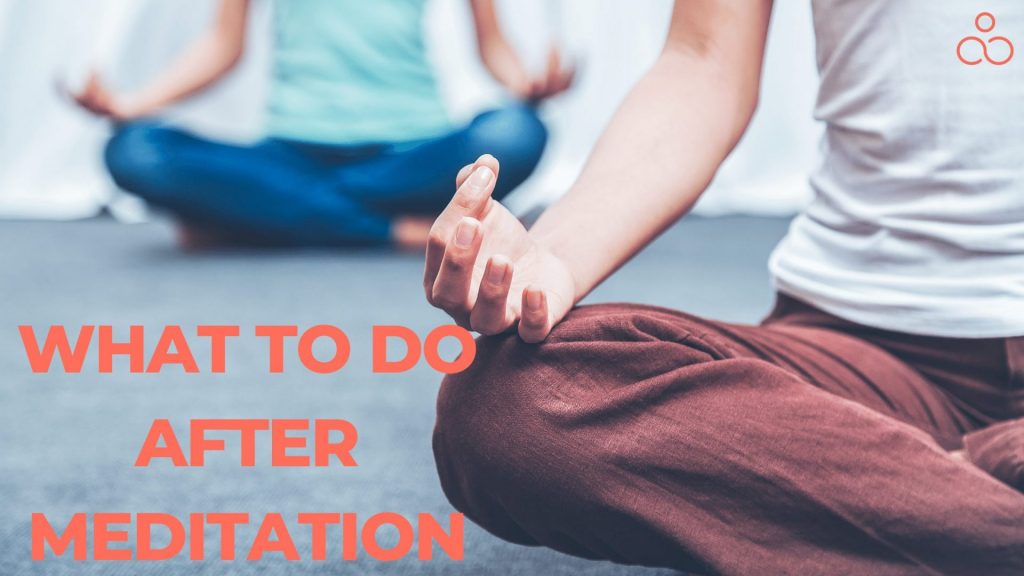After completing a meditation session, we often experience deep peace, stillness, and happiness. However, as we go about our daily routines, this pleasant sense of tranquility tends to fade away gradually.
Imagine being able to maintain that calm state throughout the entire day, unaffected by life’s ups and downs. By making adjustments to our daily activities and habits, we can prolong that soothing meditation experience and enjoy a peaceful, content life.
This article will explore meditation & its perks, preparation tips and what to do after meditation, what to avoid, and strategies to tackle challenges while incorporating mindfulness into your everyday routine.
Meditation & Its Benefits
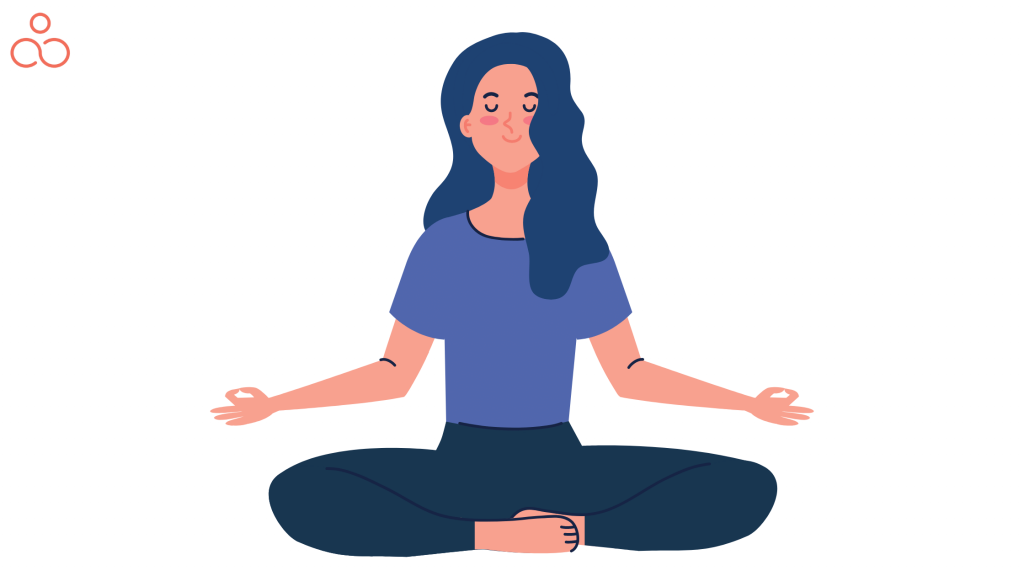
Meditation, an ancient practice with a history spanning thousands of years, remains popular across the world due to its positive impacts on brain health and well-being. As modern technology advances, researchers keep uncovering new insights into the benefits of meditation and the reasons for its effectiveness.
Reduced Stress And Anxiety Levels
Meditation greatly lowers stress and anxiety levels. During a peaceful meditation, your heart rate decreases, and breathing gets deeper, indicating your body is relaxing. This calm state reduces the stress hormone cortisol, boosting mental strength against future anxious situations.
Improved Focus And Concentration
Meditation also enhances focus and concentration. Many people feel less distracted after meditating for a few minutes. Adding mindfulness practices like meditation to your routine improves mental clarity, spirituality, self-reflection, and relaxation.
Increased Mindfulness And Awareness
Practicing meditation regularly boosts mindfulness and awareness. It helps you stay present in the moment and understand your thoughts and emotions better. After meditating, take time to assess how you feel physically and emotionally to identify any areas needing improvement.
What To Do Before Meditation
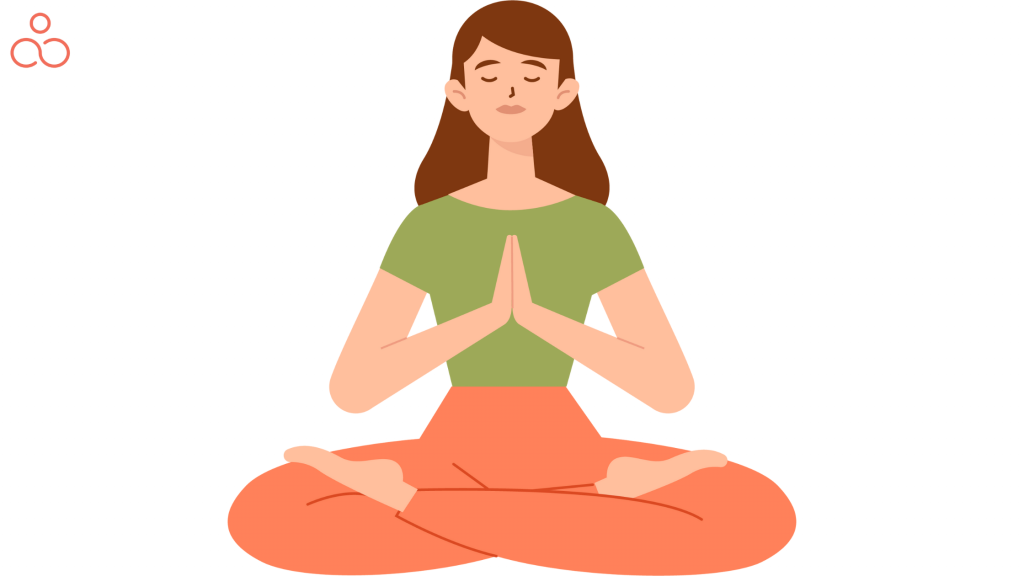
Before meditating, ensure proper preparation for a successful session.
1. Set up your space
Create a peaceful, quiet, and distraction-free meditation space. Clean the room, reduce noise (use noise-canceling headphones if needed), and gather necessary items like a meditation chair.
2. Choose your technique
Select your meditation method before starting to avoid confusion. Remember all the steps for your chosen technique. For simple mindful breathing, you may not need instructions, but for performing advanced techniques like Chakra Dhyana, you should have the instructions available.
3. Prepare your mindset
Be relaxed before meditating. Try mindful stretching or calming music to settle your mind. Set your intention and remind yourself of your meditation purpose.
4. Adjust your posture
Ensure proper posture and comfort to avoid fidgeting during meditation. Consider using a meditation chair to achieve the desired position.
5. Set your intention
Remind yourself that during your twenty-minute meditation session, you only need to be still and focused, free from worries and distractions. Setting this intention helps keep distractions at bay.
These steps will help you prepare effectively for meditation and enhance your overall experience.
What To Do After Meditation
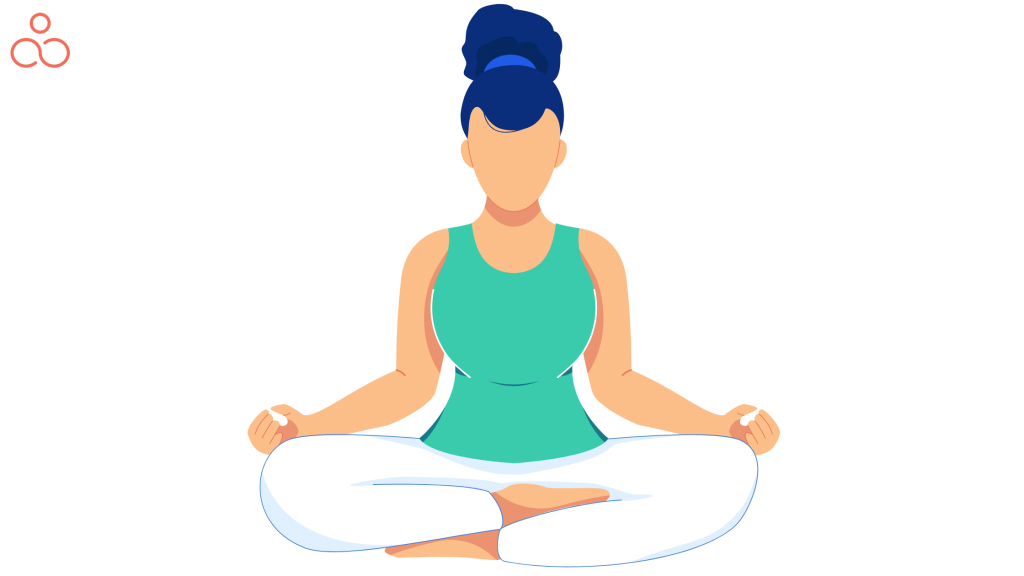
To fully reap the rewards of meditation, engage in various activities afterward. As a beginner, initial confusion is normal. But as you meditate more, you’ll grow in awareness of your mind and body, guiding you on what to do post-meditation.
Here are some suggested activities to consider after your session:
1. End Your Meditation with Deep Breaths
After finishing your meditation, take several deep breaths to gently return to the present moment. Inhale fully, fill your lungs with air, pause briefly, and then exhale slowly. Deep breathing activates the parasympathetic nervous system, which helps you relax and lowers stress. It also enhances oxygen circulation in your body, resulting in better mental clarity and focus. Practicing these mindful breaths after meditation can prolong its positive effects beyond just sitting in stillness.
2. Stretching and Light Yoga Post-Meditation
Following your meditation session, gently move your body to boost circulation and ease tension. Try these simple stretches or light yoga poses:
- Begin with easy neck stretches, tilting your head side to side and then forward and back.
- Perform seated spinal twists, using one hand on the opposite knee to twist your torso sideways.
- Practice cat-cow movements in the tabletop position, arching your spine while inhaling and rounding it on exhaling.
- Move into a downward-facing dog pose, pedaling your legs by bending your knees alternately.
- Sit in a child’s pose with arms extended forward, resting your forehead on the mat.
- Finish with seated forward folds for stretching hamstrings and lower back.
3. Maintain a Gratitude Journal
Enhance your meditation results by noting down things you’re thankful for in a journal. Spend a few minutes daily to recognize life’s little joys, encouraging positivity and overall well-being. If you’re new to this, begin with one or two points each day and slowly expand. Try experimenting with various styles – simple bullet points, detailed paragraphs, or even adding images.
4. Practice Mindfulness in Everyday Activities
Mindfulness isn’t limited to meditation; it’s about being engaged and focused during everyday activities. Here are simple ways to be mindful daily:
- Mindful Eating: Savor your food’s flavors, textures, and aroma rather than eating mindlessly.
- Mindful Walking: Observe your surroundings and body sensations while walking.
- Mindful Communication: Actively listen and fully engage in conversations with others.
- Mindful Cleaning: Tackle household chores purposefully and intentionally.
- Mindful Breathing: Take several deep breaths during the day to stay grounded.
- Mindful Driving: Remain alert and attentive while driving by concentrating on the road and traffic.
By adding mindfulness to our daily routine, we maintain a more present, calm, and balanced life. Remember, mindfulness is about awareness, curiosity, and kindness rather than perfection.
5. Immerse Yourself in Nature
After meditating, connect with nature to enhance the serenity and calmness you’ve achieved. Nature inspires, grounds, and revitalizes you, keeping you mindful in the present. Enjoy a relaxing walk in a park or forest, sit under a tree, observe birds flying, or admire blossoming flowers. Breathe deeply and fully embrace nature’s offerings.
6. Pursue a Hobby or Creative Pursuit
Maximize meditation benefits by partaking in a hobby or creative activity afterward. Doing something you love helps ground and center you while inducing joy and relaxation. It’s especially beneficial for those dealing with stress or anxiety. Instead of feeling overwhelmed, hobbies and creative projects serve as excellent outlets for releasing tension and negative emotions.
For instance, engage in art forms like painting or drawing after meditation to relax and explore your creativity. Art can be therapeutic, helps calm your nerves, further extend the effects of meditation, and offers a soothing escape when needed.
6 Ways to Maintain Your Positive Progress Post – Meditation
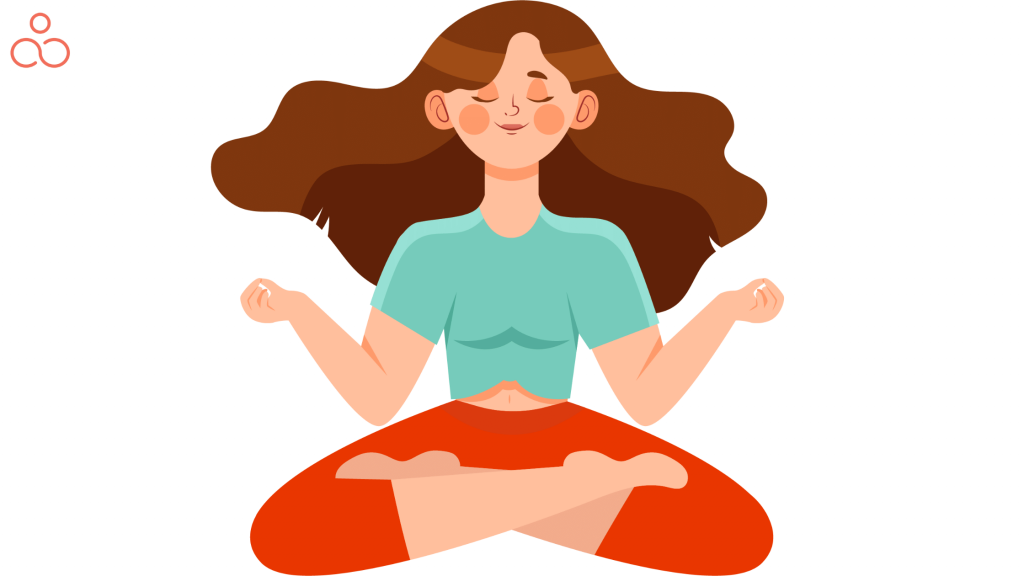
1. Share Love and Compassion
To strengthen your meditation progress, practice cultivating love & compassion for yourself and others. Send positive thoughts and wishes by silently repeating phrases like “May I be happy and healthy” or “May everyone be safe and joyful.” Studies show that this practice can reduce depression and anxiety while boosting well-being and social connections. Without any special equipment or training requirements, spending a few moments each day showing kindness to yourself and others can greatly impact mental health and life perspectives.
2. Set an Intention
Establishing a purpose after meditation helps maintain progress and adds focus to your day. A purpose is a statement that embodies your desired outcomes or manifestations in life.
For instance, intending for a productive day increases the likelihood of concentrating on tasks instead of becoming side-tracked by distractions like social media. After meditation, take deep breaths, consider what matters most, and write down one or two sentences capturing this idea. Revisit it throughout the day as a reminder.
3. Visualize Your Dreams
Visualizing your dreams is a potent tool to strengthen your meditation progress. After meditating, close your eyes and picture yourself accomplishing your goals, like getting a job promotion or completing a marathon.
For instance, if you want to improve public speaking confidence, envision yourself on stage with poise. Imagine the captivated audience applauding at the end of your speech.
Hold this image briefly before returning to reality.
4. Journaling
What to do after a powerful meditation experience? Journaling effectively helps you process and understand insights from meditation. This practice allows you to explore thoughts, feelings, and sensations, enhancing self-awareness.
- Begin by writing whatever comes to mind, such as phrases, images, or emotions.
- Another method involves using writing prompts related to gratitude, intention setting, or visualization exercises. For example, note five grateful items each day after meditating.
Journaling can also aid problem-solving or cultivate creative ideas from meditation sessions.
Overall, journaling is a versatile mindfulness practice that deepens your connection with yourself and the surrounding world.
5. Pray or meditate
To reinforce your progress after meditating, try praying or doing more meditation. Spend a few minutes expressing thanks or seeking guidance from a higher power, whatever that means to you. If you’d rather keep meditating, try different methods like chanting mantras or focusing on specific body energy centers. The goal is to find what suits you best and include it in your daily routine for inner peace and mindfulness.
6. Engage in mindfulness activities
Practicing mindfulness activities after meditation can enhance your practice and keep you calm all day. Here are some suggested activities:
- Go for a mindful walk, practice yoga, or do tai chi.
- Practice gratitude by appreciating your surroundings or writing down what you’re grateful for.
- Focus on your breath with deep breathing exercises.
- Connect with nature by spending time outdoors, like hiking or relaxing in a park.
- Engage in creative pursuits like drawing, painting, or writing for self-expression and reflection.
- Try energy therapies like Reiki or acupuncture for relaxation and balance.
*Important Note: Pay attention to how you feel after meditating, and pick the activity that resonates with you most. Stay present during these activities and concentrate on connecting with yourself.
Overcoming Challenges Through Simple Meditation and Mindfulness Techniques
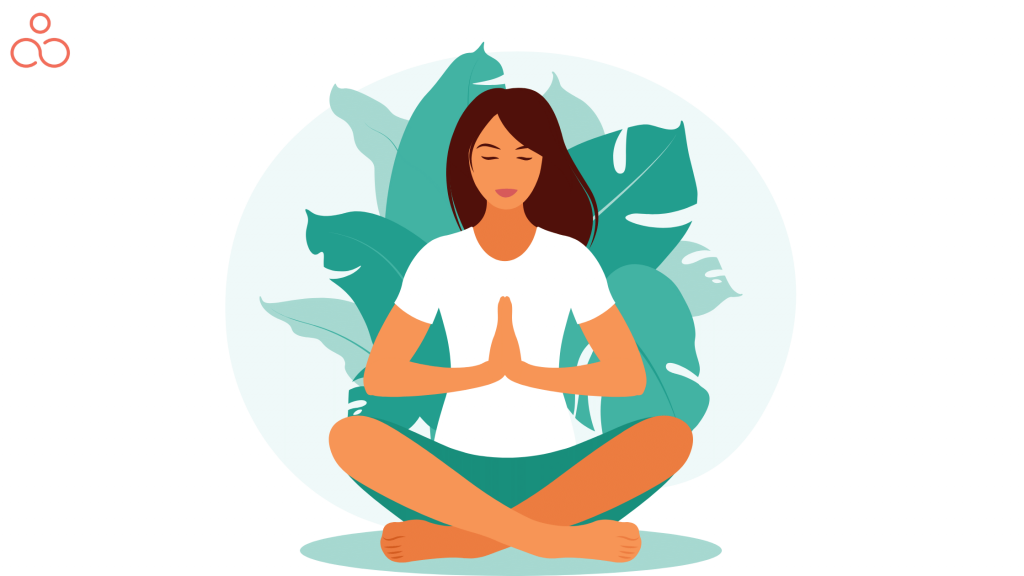
1. Handling Distractions and Thoughts
During meditation, it’s normal to have distractions and thoughts. To manage them, observe and acknowledge them, then gently refocus on your breath or mantra. Resolve underlying issues causing distractions by writing worries down before meditating. Also, practicing mindfulness daily can help minimize racing thoughts.
2. Staying Motivated for Routine Meditation
To maintain daily meditation, stay motivated by connecting with others who meditate and sharing experiences. Set realistic goals, starting with short sessions that gradually increase in length. Choose a fixed time each day for consistency, and keep the benefits of meditation in mind. Celebrate small achievements to stay encouraged.
3. Managing Expectations and Embracing Limitations
Meditation can be tough at times. Embrace challenges, and don’t get discouraged. Start with shorter sessions if you’re busy, and build up slowly to avoid burnout. Be kind to yourself during the process, set realistic goals, and treat yourself with compassion.
Tips for Incorporating Meditation into Your Daily Practice
1. Establish a Consistent Meditation Routine
To build a strong meditation habit, choose a regular time and place. This creates a routine, making it easier to maintain your practice. Pick a time with minimal distractions, like early morning or before bed. Don’t worry if you occasionally miss a session – just keep going and stay committed.
2. Begin with Short Sessions and Progress Gradually
When starting meditation, set realistic goals. Begin with five-minute sessions and then gradually increase the duration as you get comfortable. You can split longer sessions into shorter ones if needed. Meditation isn’t about competition; it’s about connecting with yourself in the present moment.
3. Explore Various Meditation Techniques
If you’re experienced in meditation, consider trying out different methods to find the best fit for you. Some options include:
- Mindfulness meditation: Stay in the present moment, and observe your thoughts and feelings without judgment.
- Loving-kindness meditation: Direct love and kindness to yourself and others.
- Transcendental Meditation: Use a mantra to quiet the mind and reach deep relaxation.
- Zen meditation: Practice Buddhist meditation with breath control and good posture.
- Vipassana Meditation: Emphasize self-awareness and balance from an ancient Indian technique.
- Yoga Nidra: Experience “yogic sleep” for deep, restorative relaxation through guided practice.
- Chakra Meditation: Balance your body’s energy centers with visualization, breathing, and intention-setting.
4. Try Guided Meditation Apps Or Videos
Using guided meditation apps or videos is a great way to boost your meditation routine. They offer guidance and structure, making it simpler for beginners. Many guided meditations include relaxing sounds or music for an even better experience. The aim is not only to depend on these apps but also to incorporate them into your mindfulness practice, promoting inner peace, mental calmness, and remaining grounded every day.
Key Points To Remember!
- After meditation, breathe deeply and do some light stretches or practice yoga for a smooth transition into your daily life.
- Practice mindfulness in everyday tasks like eating, walking, and driving to stay calm and focused.
- Enjoy hobbies or creative pursuits post-meditation for relaxation, self-awareness, and stress reduction.
- Progress by setting intentions, sharing love, and visualizing dreams to guide thoughts and actions toward goal achievement.
FAQ’s
How should I conclude my meditation session?
The crucial part after meditation is how you finish it.
- Gradually end your session, taking at least a minute to smoothly transition.
- Once you’re done, before opening your eyes, refocus on your body – wiggle your fingers and toes or sway gently.
- Open your eyes as if gently waking up, letting your body “stretch” or “yawn.”
- Exiting meditation slowly helps you stay grounded and not get overwhelmed by upcoming tasks.
- You can even add a prayer, gratitude expression, or intention for the next part of your day while holding your hands together or placing them on your heart.
What to do with all the energy built up after chakra meditation?
To utilize the energy built up after chakra meditation, focus on channeling this energy into creative or physical activities, such as painting, writing, dancing, or yoga. This will help maintain energetic balance and convert the energy into a positive force for personal growth and healing.
What to do after a retreat meditation?
After a retreat meditation, take a few moments to gently bring your awareness back to your surroundings. Gradually transition back into your daily routine by engaging in mindful activities like slow walks, journaling, or breathing exercises. Maintain the inner peace and mindfulness cultivated during the retreat by setting aside regular time for meditation in your daily life.
Is it okay to eat after meditating?
Indeed, there’s no issue with eating post-meditation; it’s a matter of personal choice. However, many traditions advise against eating before meditation to prevent discomfort and drowsiness. It’s recommended to wait an hour after eating or consume a light meal before meditating.
What not to do after meditation?
After emerging from a calm meditation, always dodge gossip and self-conflict, as well as belittling others, feeding the ego, and triggering negative emotions. These actions can disrupt your mood and atmosphere, harming your inner peace and happiness. So, always stay away from negativity post-meditation.
How can I keep feeling relaxed and focused after meditating?
Doing mindful activities like breathing techniques, writing in a gratitude journal, or practicing yoga can help you stay calm and focused. Also, avoiding stressful situations when possible may help you stay peaceful for the rest of the day and sleep better at night.
What to do after reaching transcendental state meditation?
Upon reaching a transcendental state in meditation, gently bring your awareness back to your breath. Gradually transition to normal consciousness, taking time to become familiar with your surroundings. Reflect on your experience and consider noting insights or observations for future reference. Continue practicing regularly to cultivate deeper states of meditation and personal growth.
Conclusion
Meditation offers great benefits when done correctly. To feel the effects quickly and efficiently, engage in suitable activities after meditating like practicing mindfulness, journaling, or trying hobbies, and avoid those that may slow you down or promote laziness. Staying busy after meditating helps sharpen your mind and focus.
Meditation’s popularity stems from its ability to increase self-awareness and mental strength, making it an excellent tool for self-improvement. By maintaining regular meditation practice and exploring various techniques, we can achieve inner peace, clear thinking, and a deeper connection with ourselves.

